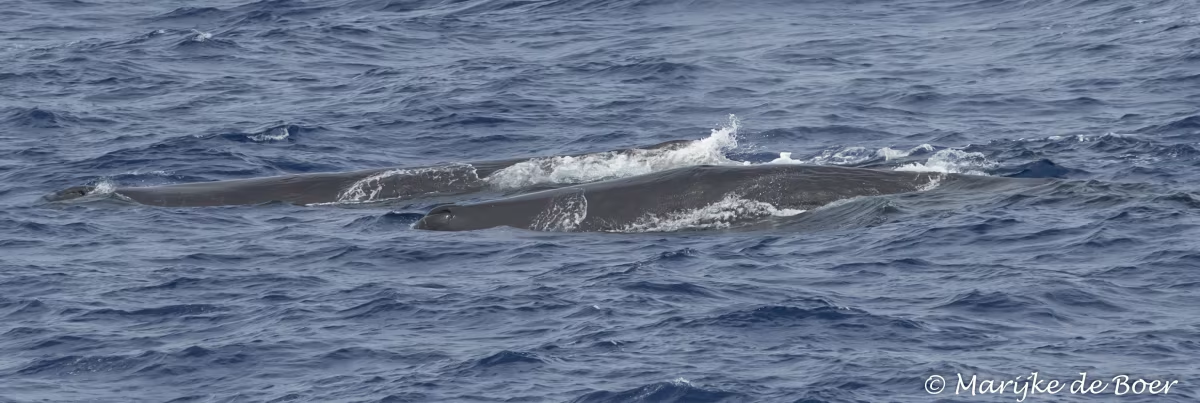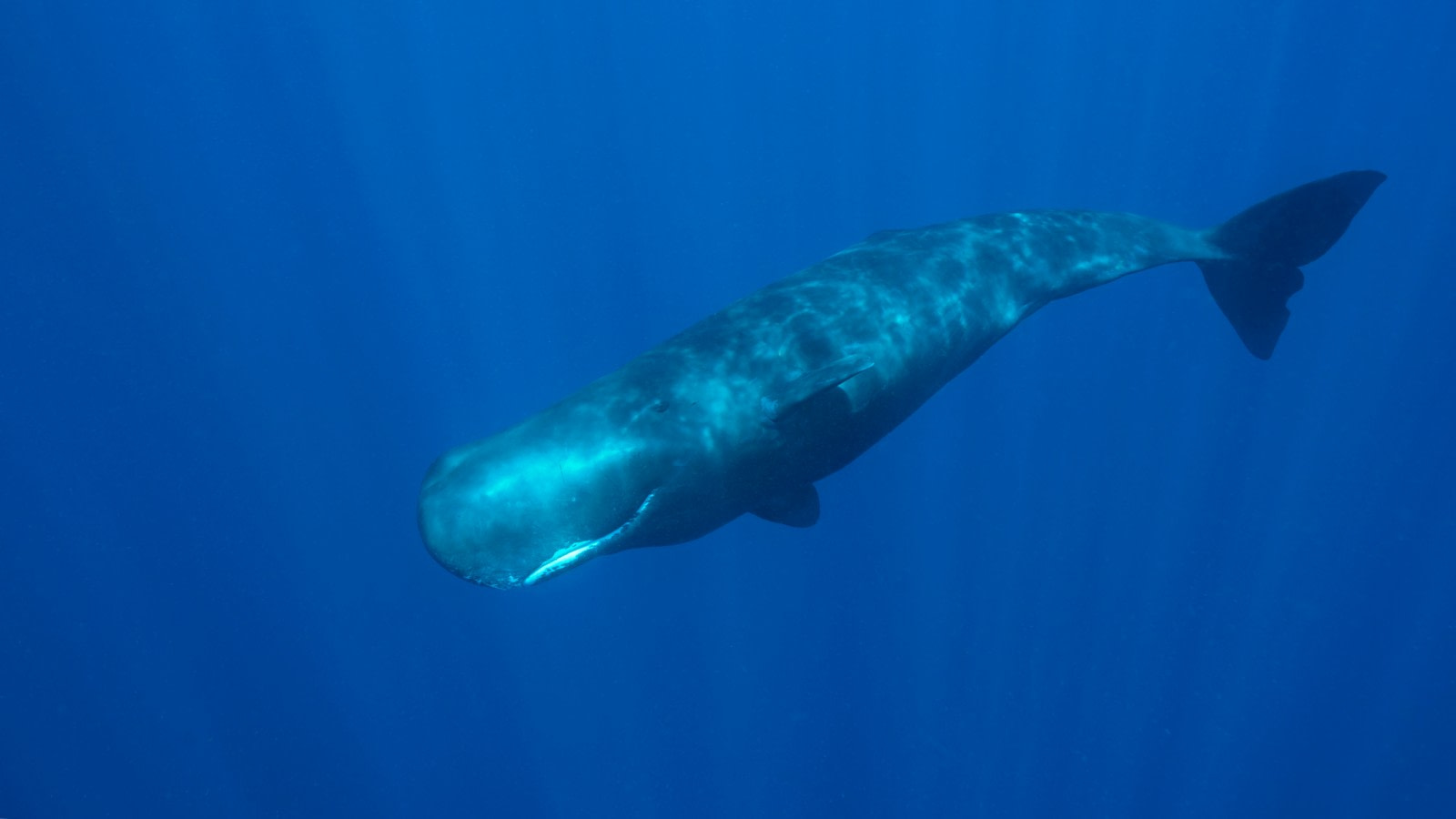Name: Sperm whale (Physeter macrocephalus)
Length: 16-20 metres (53-66 feet)
Weight: 40,000-55,000 kg (88,000- 12,000 pounds)
Location: Sub-Arctic, sub-Antarctic, and Atlantic waters
Conservation status: Vulnerable
Diet: Mainly squid, but also fish, octopi, rays, and megamouth sharks
Appearance: Long, block-shaped head comprising up to 1/3 of the whale’s body, with grey or black skin, which tends to be wrinkled behind the head and on the sides. Short, wide flippers, broad, triangular fluke, and a single blowhole.

Picture by Thomas Laumeyer
How do sperm whales hunt?
Sperm whales usually eat a little over 900 kg (almost 2,000 pounds) of food per day. To find their prey (preferably giant squid), they dive somewhere between 300 and 1,200 metres (990 and 4,000 feet), though they can go as deep as 2 km (1.2 miles) while on the hunt. An average dive lasts about an hour.
Using echolocation to focus on their prey, sperm whales generate a series of clicks that are the loudest animal-caused noises in the world.
A sperm whale’s teeth along its bottom jaw are about 18 to 20 cm long (7.1 to 7.9 inches), fitting into sockets along the underside of the palate. The upper teeth of a sperm whale never grow out of its upper jaw.
Scientists believe that sperm whales and giant squid are natural enemies. While no actual battles have ever been observed, sperm whales sometimes carry round scars believed to have come from the suckers of giant squid.
When hunting smaller fish, sperm whale pods can work together to force feeder fish into ball-like clumps that are more substantial to eat than individuals.
Are sperm whales social?
When they are not breeding, adult male sperm whales live on their own. Female sperm whales and offspring, however, gather into pods of up to 20 members. The male sperm whale generally leave around 4 years old, sometimes forming a pod of its own with other young adult males. This pod will also eventually split up as the males age.
Adult male sperm whales are the only members of the species that venture into the colder waters approaching the poles, while the pods of female and young sperm whales remain in tropical and temperate zones.
Sperm whales spend most of their time on the hunt, but sometimes they break off in the afternoon to engage in more social behaviour. This includes calling to each other and rubbing against each other.
When attacked, sperm whales form a “marguerite formation,” surrounding a vulnerable pod member with their tails thrust outward to ward off harassers.

How fast can sperm whales swim?
A sperm whale’s normal cruising speed ranges somewhere around 5 to 15 kph (3 to 9 mph). When they speed up, sperm whales can swim approximately 35 to 45 kph (22 to 28 mph), and they can maintain these speeds for about an hour.
What are sperm whale mating rituals like?
Sperm whale males reach sexual maturity around 18 years old and females at 9 years old. Males battle for mating rights, then breed with multiple females. Male sperm whales do not create harems of females like other animals.
The sperm whale pregnancy term lasts about 15 months, resulting in a single calf. The birth is a social event, with the rest of the sperm whale pod forming a protective barrier around the birthing mother and her calf. Female sperm whales mate once every 4 to 20 years until they are about 40 years old.
How long do sperm whales live?
Sperm whales have a lifespan similar to humans, living about 70 years. Males do not reach full size until they are about 50.
How many sperm whales are there today?
Global abundance is not known but is broadly estimated to be about 360,000, making sperm whales one of the most abundant of all the great whales .
Do sperm whales have any predators?
Orcas are the largest natural threat to sperm whales, though pilot whales and false killer whales are also known to hunt them. Orcas go after entire sperm whale pods and will try to take a calf or even a female, but the male sperm whales are generally too big and aggressive to be hunted.
Aside from the usual commodities (food, blubber, oil), sperm whales have other materials that were valuable during the high whaling eras:
- Spermaceti – A waxy substance used in a variety of pharmaceuticals as well as candles, ointments, cosmetics, and weather proofing
- Ambergris – Waxy and flammable, this material forms in the sperm whale’s digestive track by irritation from squid beaks. Sperm whales produce it over the course of years to help with the passing of objects that do not otherwise break down in their digestive track. Ambergris was heavily used by the perfume industry, but its rarity eventually led to the search for other substances.

Do sperm whales attack people?
While sperm whales generally retreat from ships, on very rare occasions they have been known to ram small boats. Some scientists believe sperm whales remember past human aggression and have become hostile, but others think their collisions are purely accidental.
Seven suitable sperm whale facts
- Sperm whales have the biggest heads and brains on Earth. Their brains are five times heavier than a human’s.
- The white whale in Moby Dick was based on two real-life sperm whales: a whale that rammed and sank the ship Essex and an albino adult male named Mocha Dick.
- Sperm whales are named after the spermaceti pulled from their bodies.
- Sperm whales fertilize the oceans with their feces, which floats upward and is consumed by phytoplankton.
- Male adult sperm whales very occasionally have been known to attack orcas to compete for food.
- A sperm whale’s heart weighs about the same as two average adult male humans (125 kg or 275 pounds).
- The highest sound pressure level ever recorded from an animal was from a sperm whale off the coast of northern Norway. The single click reached 235 (dB re 1 μ Pa), which is equal to the sound pressure of the Saturn V rocket heard at about one meter distance (3 feet). This recording proved the “the Big Bang” hypothesis, which stated that sperm whales could stun or even kill prey with sound.



